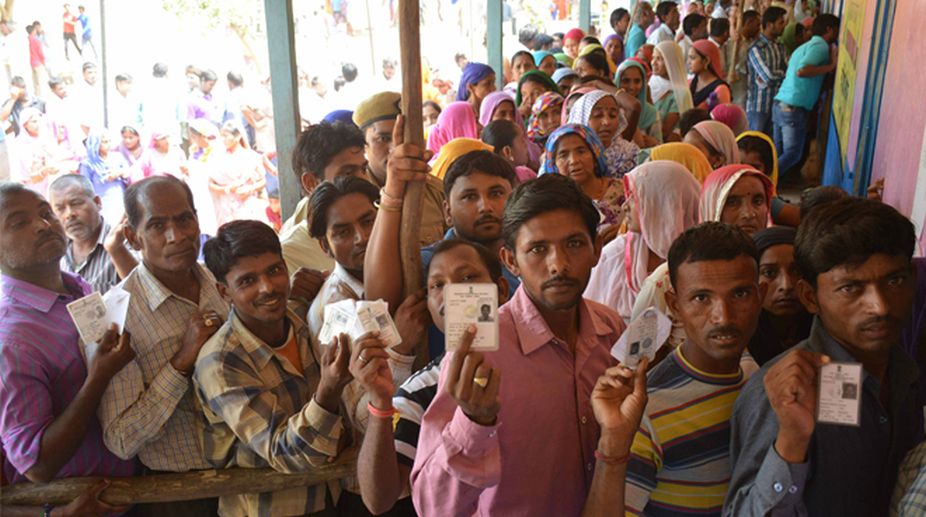Congress committing dacoity on rights of OBCs, SCs, STs: PM
“Wherever it (Congress) can do it, it will try to loot the claims of the SCs, STs and OBCs and give them to others,” said Modi.

Representational Image (Photo: SNS/File)
The entire country is focusing on the Gujarat Assembly elections 2017, as they are turning out to be the most closely fought elections in recent times in the Prime Minister Narendra Modi’s home state.
Gujarat, a BJP bastion for last 22 years, is now witnessing a re-emergence of Congress party, which is projecting itself as a serious challenger in the elections. Both the political parties, Bharatiya Janata Party (BJP) and the Congress, see the elections as a battle of prestige and one-upmanship.
Around 30 per cent votes have been polled till noon for the first phase of Gujarat elections, reports said. The voting was 29% in Surendranagar, 31% in Porbandar, 30% in Morbi, 29% in Jamnagar, 28% in Junagad, 28% in Gir-Somnath, 32% in amreli, 31% in Bhavnagar, 30% in Botad, 23% in Narmada, 32% in surat, 27% in Tapi, 28% in Bharuch, 26% in in Navsari, 27% in Dangs, 28% in Valsad, 32% in Rajkot, 27% in Kutch and 30% in Dwarka.
Advertisement
For the total number of 182 constituencies going to polls in the two-phase elections, the first phase will see polling in 89 constituencies and from a total electorate of 4.35 crore, 2.12 crore voters are expected to use their right to vote today.
Gujarat Chief Minister Vijay Rupani, with 977 other candidates, will contest in the first phase elections for which the Election Commission (EC) has set-up 50128 election booths with VVPAT facility for voting.
The first phase will see more young faces voting with 50 per cent of the total candidates being below 40 years of age.
Of the 977 candidates trying their luck in the elections, there are 57 women candidates and 443 independent candidates in fray.
The prime focus is on Surat and the Rajkot seats. Gujarat Chief Minister Vijay Rupani is contesting a prestige battle from Rajkot West.
Many popular leaders from both the parties are contesting in the first phase of elections. From BJP the popular ones are Vijay Rupani, Jitu Vaghani, Babu Bokhiriya against Congress’s ex-state chief Arjun Modhwadia, Shaktisinh Gohil and Paresh Dhanani.
From the constituencies going to polls in the first phase, Saurashtra has 54 seats and South Gujarat has 35 seats. In 2012, from Saurashtra’s 54 seats, BJP took 34 seats and Congress could only get 20 seats.
Saurashtra has a maximum number of Leuva Patel population, who were not a part of Patel agitation and 38 seats out of these 54 seats are Leuva Patel dominant constituencies.
Though BJP is not expected to get affected as these seats are not Patidar seats, however, Patels can still turn out to be a game changer for either of the parties.
The polling is being held in 19 districts of Saurashtra, Kutch and South Gujarat, which are primarily Patidar dominated region and there is a great deal of discussion about how will the Patidar community vote.
The 89 constituencies of the first phase comprise of 10 talukas, 939 villages and 6 municipal corporations. The first phase of Gujarat Assembly Elections covers the entire Saurashtra-Kutch and the South Gujarat. The districts that will be a part this region are Kutch, Surendranagar, Morbi, Rajkot, Jamnagar, Devbhoomi, Dwarka, Porbandar, Junagadh, Gir Somnath, Amreli, Bhavnagar, Botad, Narmada, Bharuch, Surat, Tapi, Dang, Navsari and Valsad districts.
The first round of polls is crucial for both BJP and Congress party, as it would be interesting to see how the factions within the ‘Patidar’ community vote.
Advertisement